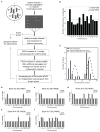Aneuploidy confers quantitative proteome changes and phenotypic variation in budding yeast
- PMID: 20962780
- PMCID: PMC2978756
- DOI: 10.1038/nature09529
Aneuploidy confers quantitative proteome changes and phenotypic variation in budding yeast
Abstract
Aneuploidy, referring here to genome contents characterized by abnormal numbers of chromosomes, has been associated with developmental defects, cancer and adaptive evolution in experimental organisms. However, it remains unresolved how aneuploidy impacts gene expression and whether aneuploidy could directly bring about phenotypic variation and improved fitness over that of euploid counterparts. Here we show, using quantitative mass spectrometry-based proteomics and phenotypic profiling, that levels of protein expression in aneuploid yeast strains largely scale with chromosome copy numbers, following the same trend as that observed for the transcriptome, and that aneuploidy confers diverse phenotypes. We designed a novel scheme to generate, through random meiotic segregation, 38 stable and fully isogenic aneuploid yeast strains with distinct karyotypes and genome contents between 1N and 3N without involving any genetic selection. Through quantitative growth assays under various conditions or in the presence of a panel of chemotherapeutic or antifungal drugs, we found that some aneuploid strains grew significantly better than euploid control strains under conditions suboptimal for the latter. These results provide strong evidence that aneuploidy directly affects gene expression at both the transcriptome and proteome levels and can generate significant phenotypic variation that could bring about fitness gains under diverse conditions. Our findings suggest that the fitness ranking between euploid and aneuploid cells is dependent on context and karyotype, providing the basis for the notion that aneuploidy can directly underlie phenotypic evolution and cellular adaptation.
Figures



Comment in
-
Evolutionary genomics: When abnormality is beneficial.Nature. 2010 Nov 11;468(7321):183-4. doi: 10.1038/468183a. Nature. 2010. PMID: 21068824 No abstract available.
References
-
- Weaver BA, Cleveland DW. Does aneuploidy cause cancer? Curr Opin Cell Biol. 2006;18:658–667. - PubMed
Publication types
MeSH terms
Substances
Grants and funding
LinkOut - more resources
Full Text Sources
Other Literature Sources
Molecular Biology Databases

